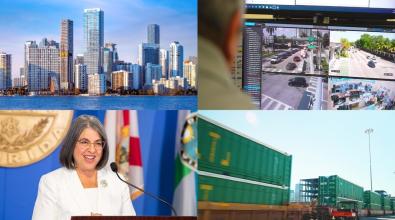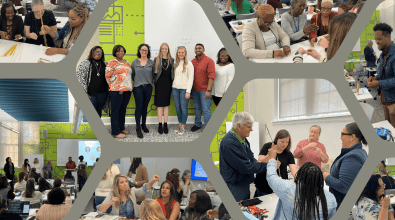 Read More
Read More
Problem-based procurement is crowding in new solutions

Listen to This Article
More than ever before, cities are serving as platforms that connect actors inside and outside of government to surface new solutions. And one of the most promising ways city leaders are getting it done is with a twist to an age-old process: procurement.
Instead of seeking the best price for a defined product, cities are increasingly engaged in problem- or challenge-based procurement that identifies a need but does not specify what a solution looks like. This tactic has been slowly gaining steam over the last decade and is starting to produce exciting new results in cities. From measuring park use to cleaning up electronic waste to using predictive analytics for the maintenance of city fleets, here’s how getting bolder with procurement is making a difference.
What is problem-based procurement?
If the procurement process traditionally hinges on highly specific requests from cities geared at vendors in their business community, problem-based procurement is about sparking greater creativity—and possibly even the invention of new products. In instances where city leaders need fixes for emerging or novel challenges, they can flip the script on the procurement process in order to invite idea generators rather than implementers of familiar solutions.
An early precedent for this work that helped lay the foundation for more recent problem-based procurement came in 2011 in Stockholm. The city was determined to improve public-space access for the visually impaired but was at a loss for how to go about it. Local leaders engaged deeply with advocates for and members of the community to uncover a solution that leveraged users' cell phones to help them safely navigate to libraries, restaurants, and more. The project had positive spillover effects, too, with one estimate identifying millions of dollars in potential savings for the city because of reduced need for services such as paratransit vehicles.
Now the promise of problem-based procurement is clearer than ever. It helped Boston bring in twice as many bids as usual in developing a new internal IT system for managing capital construction projects. And, this year, it’s helped leaders in the state of California test genAI’s potential for investigating traffic risks and monitoring interventions designed to increase street safety.
How other cities can get started.
Problem-based procurement has a foothold in a growing number of cities. But for many others, where it still represents a new way of working, there are simple ways to ease into this approach.
This starts with putting together problem statements. All this means is taking the time in requests for proposals (RFPs) to clearly lay out the challenge the procurement is meant to address, and acknowledge the need for new ideas.
“Many cities don't yet include a description of the problem they face in a typical RFP,” notes Elena Hoffnagle, director of procurement scaling & innovation at the Government Performance Lab (GPL) at the Harvard Kennedy School. She argues problem statements are very much worthwhile, as they help “push a prospective vendor to think and really understand the challenge and context.”
When they are ready to issue a broader call for new solutions, cities can take steps to get the word out beyond their typical vendors. Barcelona tested problem-based procurement to invite new solutions to challenges such as social isolation, bike theft, and monitoring pedestrian flows. To ensure new actors took part in the effort, the city used simple, clear messaging online and in public spaces, such as subway stations. Ultimately, the project brought in well over 100 bids and rolled out new solutions, such as a thermal video sensor tool intended to help officials gauge foot traffic in public spaces during major events.
What kinds of challenges can problem-based procurement address?
In Long Beach, Calif., local leaders recently launched a new initiative called LB Co-Lab that is based on the principles of problem-based procurement. Except in their case, residents aren’t only involved in surfacing new ideas but also in determining the problems that warrant crowdsourcing in the first place. Public safety soon emerged as a focal point, and the city has since begun to pilot a series of “smart lights,” powered by wind and solar, to help illuminate a neighborhood.
More broadly, problem-based procurement is especially appealing for local leaders grappling with policy areas where past contracts have repeatedly fallen short. And it creates new possibilities on some of the most existential issues cities face, such as climate change.
“This is showing up frequently in the climate and sustainability sector,” Hoffnagle says. “There are many new technologies that are more climate-friendly that cities just don't know about.” Problem-based procurement can help.
How can cities take this work to the next level?
It’s one thing to identify challenges and crowdsource solutions. It’s quite another for cities to expand their visibility by inviting pitches for almost anything at all, and, in doing so, address potential blind spots in their approach to local challenges. And yet cities are finding ways to do this strategically—and getting results.
Long Beach is doing so with a program called “Pitch Long Beach!” that formalizes what has always happened in cities: procurement managers and other leaders getting pitched by vendors even when they haven’t put out calls for proposals. Now, the city has created a mechanism for inviting pitches that meet any need—and then determining whether a new idea is consistent with a local priority and worth piloting. Local leaders recently accepted a pitch for devices that send alerts when vehicle tires are losing pressure, using them to reduce breakdowns on the city’s fleet. The project is helping the city move from preventive maintenance to predictive maintenance, and estimates peg possible cost savings in the six figures.
Whether it’s open-ended pitch callouts or more targeted problem-based procurements framed around specific challenges, this work is increasingly helping cities be more sustainable. In Philadelphia, a challenge calling for new approaches to reducing waste in landfills produced an “urban mining” data tool intended to anticipate when materials from building demolitions can be reused—and even identify where that reuse can take place. As part of the same challenge, the city also piloted a service collecting textile (clothing) and electronic waste from residents’ homes.
Kitchener, Canada, is taking challenge-based procurement one step further. Because these purchases often start as pilot projects, the city—which has taken part in procurement training with GPL and the Bloomberg Harvard City Leadership Initiative—is using this work to explore new ways to scale pilots into long-term programs. One way to get that done is by tweaking the vendor agreements used with challenge winners.
“We haven't had a mechanism for a challenge-based focus on things that we actually want to invest in,” says Courtney Zinn, a city staff member focused on innovation who is helping coordinate this work in Kitchener. “So pairing strategic problems that we want to tackle with a more formalized structure around pilots is something we’ve talked about for a long time and is now coming to fruition.”
More broadly, city leaders describe problem-based procurement as a way to open up their eyes to a vast range of new possibilities. As Lisa Flores, the chief procurement officer in New York City, puts it, this work could help unlock “solutions that we haven’t even thought of, and solutions that might not even exist yet.”

